23 Evidence-Based Benefits of Sweet Potatoes
History
Until recently, the most commonly accepted theory as to where the sweet potato originated was that it was discovered by Spanish explorers who first came to the New World.
Many historians believe that Christopher Columbus found the sweet potato in the West Indies, but recent debate and findings from DNA technology may prove otherwise.
Some anthropologists think the sweet potato had been taken from the Andes to Polynesia long before Columbus was even born—nearly 400 years before he was born, to be exact.
Using radiocarbon dating, researchers have been able to determine the age of some prehistoric remnants of sweet potato in Polynesia from 1000 to 1100 A.D.
Many have hypothesized that these ancient remains came from the western coast of South America.
Other reasons include the origin of the name for sweet potato.
The Incan word for potato is “batata,” which is likely the origin of the modern name “potato” (1).
Botanically, the sweet potato belongs to the morning glory family.
Other members of this family include weeds that are native to Illinois and Indiana—the “wild potato vine,” “wild sweet potato,” or “man of the earth.”
Aside from America, however, the sweet potato is grown in many other countries.
Although it took almost two hundred years for the English to accept the sweet potato as an acceptable food to consume, it is now widely grown in many places, such as Japan, southern Russia, and the Pacific islands (1).

How it Grows
Because sweet potatoes are naturally native to the tropics, they grow best in such tropical regions and warm climates.
Additionally, these sweet vegetables grow best in loose, well-drained, sandy soil, but they only produce seeds when they are grown in tropical climates; otherwise, new plants can only be grown by planting their roots or cutting off their vines.
Once sweet potato plants start to grow, they require little water unless they are stricken by disease or pests.
Soil pH should be slightly acidic, between 5.8 and 6.2, but they can tolerate more acidic pH levels up to about 5.0.
Because sweet potatoes are known for their plentiful vines, it is a good idea to thoroughly weed the planted area two weeks after first planting to make your crop yield most efficiently (3).

Varieties
Many varieties of sweet potatoes are available, but three can usually be found in any local supermarket.
The first type is called the Covington sweet potato, which is a favorite for mashing or roasting.
This particular variety has rose-colored skin, with very sweet orange flesh.
Many people choose to eat these potatoes whole with assorted toppings or cut them into wedges for a bite-sized side dish.
Many consumers also turn to the O’Henry sweet potato.
Unlike the Covington, this sweet potato is a little unusual in that it more resembles an Irish potato, with pale copper-colored skin and white flesh, which tastes sweet and creamy, making it a perfect candidate to be used in soups and stews.
Finally, we have the Japanese sweet potato, with its prominent red skin and dry white flesh (4).
This type of potato is commonly roasted and used as a side dish or a snack.

Interesting Facts
Many states are proud of their lakes and national parks, but North Carolina is also quite proud of its sweet potatoes!
In fact, it is the leading producer of sweet potatoes in the United States, producing nearly 40% of the national supply!
The sweet potato is actually the state’s official vegetable!
Another interesting fact about sweet potatoes is that they are actually classified as roots.
Regular Irish potatoes, on the other hand, are considered tubers, or underground stems (5).
So unlike their very close relative, sweet potatoes do not share the same classification.
Health Benefits of Sweet Potatoes
High in Manganese
Manganese is important for the performance of enzymes in our body that metabolize carbs, proteins, and fats (7).
Several studies have been performed using rats as test models to observe the effects of manganese deficiency on carbohydrate metabolism.
When compared with non-manganese-deficient rats, rats that had this deficiency were found to have a diabetic type of glucose tolerance curve when given glucose to consume.
This suggests that manganese has a vital role in regulating blood glucose levels, which is the foundation for diabetes beginning.
Other tests performed on these subjects showed that manganese-deficient rats had an insulin output that was 76% that of control rats, meaning that either a lower amount of insulin was stored in these rats or the deficiency impaired insulin release.
From all their data, researchers concluded that manganese deficiency could result in impaired insulin release, possibly leading to abnormal carbohydrate metabolism.
Fortunately, sweet potatoes contain an abundance of manganese — about 28% of the daily recommended amount (7).
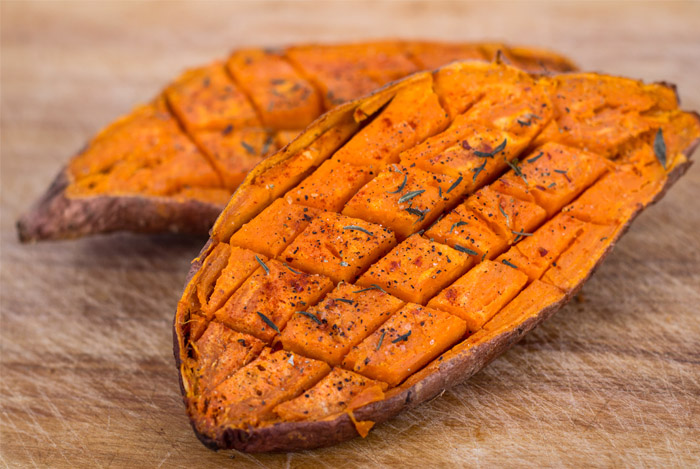
High in Vitamin A and Beta-Carotene
The brightly colored orange flesh of a sweet potato is not only its signature trademark but also carries with it much of the health benefits that sweet potatoes are known for.
Most significantly, sweet potatoes are fantastic sources of provitamin A and beta-carotene (8).
Because vitamin A deficiency is such a crisis is many developing countries, many studies have been conducted to find the most efficient ways to battle this deficiency.
One such study looked at the efficacy of consuming boiled and mashed sweet potatoes and the effect on improving the vitamin A status of school-aged children.
For fifty-three school days, children who were designated to be in the treatment group consumed boiled and mashed sweet potatoes, while the control groups consumed white-fleshed sweet potatoes without beta-carotene.
Researchers found that the proportion of children with normal vitamin A levels increased by almost 10%, while there was no significant change in normal vitamin A proportions in the control group.
With these kinds of results, along with others, it was established that eating orange-fleshed sweet potatoes could improve vitamin A deficiencies in children (8).
Help with Digestive System
One cup of baked sweet potato contains 6.6 grams of fiber (9).
Most Americans already eat less than the daily recommended amount of fiber, so finding a product that provides such a large amount of nutritional fiber is important.
About 23% of that fiber is soluble, which acts by helping you feel full in much the same way as protein works in your body.
Most of the sweet potato’s fiber, however, which is insoluble fiber, allows your digestive system to run smoothly and efficiently by adding weight to your body’s waste (10).
Doing so allows that waste to pass through your system much quicker and easier.
Most of the fiber in sweet potatoes comes from the skin, so if you want to reap the most fiber benefits from this food, be sure to leave the skin on when you are eating it.
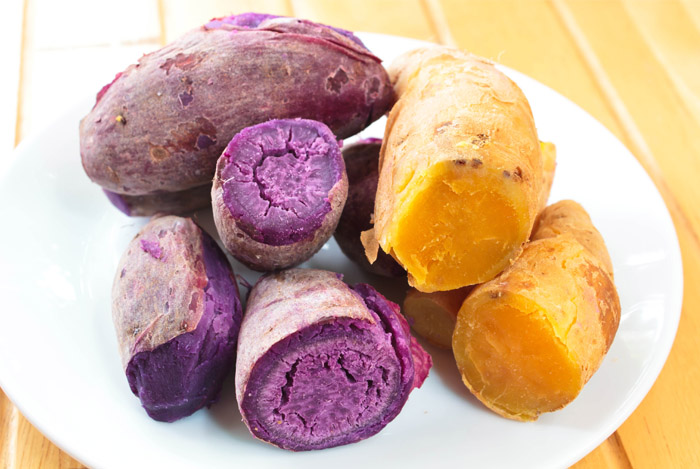
Lower Risk of Cancer
Beta-carotene helps prevent cancer, but most findings have found little to no significant relationship between beta-carotene intake and breast cancer prevention (11).
Part of the reason why this may be so is that almost all that research focused on beta-carotene consumption during adulthood on breast cancer risk.
By studying the formation of breast cancer cells and their progression, many scientists think that dietary intake of this essential nutrient ten to twenty years before diagnosis may actually be the most relevant because the mechanism by which beta-carotene reduces the risk for breast cancer includes protecting against oxidative damage (11).
By preventing excessive damage to your body years before cancer can even begin to progress and even form, it may be possible to treat cancer before it begins.
Recent results have shown that women are at a lower risk for breast cancer with increasing levels of beta-carotene consumption, although once again no evidence exists to show that there is a critical time period during which consumption of this nutrient is most beneficial (11).
Nevertheless, be sure to include the recommended amount of beta-carotene in your diet.
Luckily, sweet potatoes are packed with this nutrient, so eating healthy and reducing your risks for diseases and cancers can easily be accomplished with this vegetable.
Lower Risk of Heart Disease
Free radicals lead to many of the diseases and disabilities that come with aging.
Fortunately, researchers have also found that antioxidants vitamins, such as beta-carotene, partly prevent free radicals from damaging our bodies.
One such disease that researchers believe may benefit from beta-carotene is cardiovascular disease (12).
For decades, cardiovascular disease has been a deadly disease.
One of the major risk factors of this disease is cholesterol content, more specifically, the ratio between low-density and high-density lipoproteins.
In several studies, scientists found that a 10 mg/dL increase in LDL cholesterol in your body was associated with nearly a 12% increase in risk for CVD, showing the importance of maintaining low levels of LDL cholesterol (13).
Luckily for us, sweet potatoes are filled with beta-carotene and other antioxidants, and it is these nutrients that help combat the oxidation of LDL cholesterol (12).
Although cardiovascular disease is certainly not the only disease that is caused by oxidative damage from free radicals, it is certainly something that may be prevented by simply including beta-carotene and other healthy antioxidants in your daily diet.
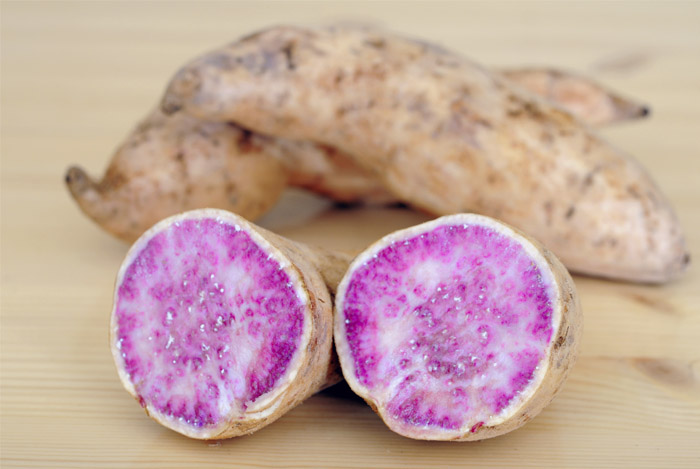
Prevent Macular Degeneration
Beta-carotene is such an essential nutrient because it is the body’s precursor to vitamin A.
Your body takes that beta-carotene that you get from all those orange fruits and vegetables and turns that antioxidant into vitamin A (14).
In fact, just a simple medium-baked sweet potato contains nearly 430% of your daily vitamin A intake.
Vitamin A is particularly important for helping maintain our eyesight and ward off macular degeneration (14).
Statistics predicts that by 2030 almost 108 million people in the word will be 55 years old or older, and we all know that the older we get, the worse our eyesight gets, which is why protecting our eyes and eating foods that will help us maintain our vision for longer is so important right now!
Many studies have been conducted using beta-carotene and vitamin A, and the results have all agreed that even a small amount of beta-carotene-rich foods helped reduce the risk of age-related macular degeneration (14).
Help Control Blood Sugar
It is not uncommon for people living with diabetes to refrain from eating starchy foods, such as potatoes since they would normally raise their blood glucose level.
Recent research, however, is showing that sweet potatoes may actually have the opposite effect on your blood sugar levels.
Sweet potatoes are known to have resistant starches and fiber that contribute to keeping your blood sugar down (15).
One particular study actually found that meals high in resistant starch or soluble fibers, both of which can be found in sweet potatoes, actually decrease your peak insulin and glucose concentrations.
Therefore, many researchers are beginning to believe that resistant starches may actually improve insulin sensitivity and decrease blood glucose levels after meals, which is something that diabetics must always be on the watch for (15).
This is not to say that those with type 2 diabetes should feast on sweet potatoes every day, but, although more research is certainly needed on the topic, it does mean that it is quite possible that diabetics need not shy away from a sweet potato every now and then.

Improve Your Immune System
Oranges, limes, lemons . . . those are the fruits that people usually think of first when trying to improve their vitamin C intake.
Citrus fruits are well-known for their immense ascorbic acid content, but you may be surprised to hear that many vegetables also contain a hearty amount of ascorbic acid, one such being is the sweet potato.
One cup of baked sweet potato has about 65% of your daily vitamin C for the day, which is an astounding amount for such an overlooked vegetable (16).
The reason vitamin C is so important to our immune system is that when we catch a cold or get an infection or illness the vitamin C in our plasma and leukocytes rapidly declines.
Supplementing vitamin C when you are sick or eating lots of food rich in vitamin C has much success in improving parts of our immune system.
It does so by improving antimicrobial and natural killer cell activities as well as lymphocyte proliferation, which is the types of blood cells that are required during infections and illnesses.
Research has also proven that adequate daily intake of vitamin C ameliorates symptoms and shortens the duration of infections, such as the common cold (17).
So if you find yourself in the midst of catching a cold anytime soon and don’t have any citrus fruits around, turn to sweet potatoes to do the job for you instead!
Maintain Healthy Teeth and Gums
Vitamin C may be the main go-to when you are trying to improve your immune system, but there are many other health benefits of vitamin C.
For example, vitamin C is highly important for gum and teeth maintenance (18).
One such disease that affects the teeth and gums is periodontitis, which is a slowly progressing infectious disease in tooth-supporting tissue.
Inflammation in the periodontal region can even result in gingival bleeding, pocket formation in the gums, and eventually loss of teeth.
Unfortunately, severe forms of this disease are much more common than you may expect, occurring in nearly 20% of the world population.
Fortunately, doctors and researchers have been at work trying to prevent and treat this disease, and they may have found an answer—vitamin C (18).
Low vitamin C concentrations in plasma have been found to be a possible risk factor for periodontitis as well as a method for possible treatment.
To be clear, this is not a cause and effect relationship — having low vitamin C concentrations does not cause periodontitis, but it does put you at a higher risk for the disease.
In many gum diseases, such as periodontitis, the tooth tissue is attacked by bacteria, which is why vitamin C is required to repair the damage that the bacteria have done (18).
Eating that extra sweet potato at dinner may save you several expensive trips to the dentist!

Prevent Wrinkles
Many people wrongly assume that wrinkles are only a natural and expected part of aging.
While this is partly correct, since your skin does naturally sag and eventually show wear and tear, there are actually many things you can do to prevent and reduce wrinkles before they even form.
The main way is to stop the degradation of primary structural constituents of the skin, such as collagen and elastin.
Doing so is the best way to stop wrinkles from forming (19).
Of course, you should always protect your skin with sunscreen and minimal UV light exposure, but collagen is at the root of the problem of wrinkles.
Luckily, vitamin C has been proven to have skin antiaging properties due to its ability to induce the production of collagen synthesis.
Additionally, vitamin C also helps produce enzymes that in turn also help produce collagen, so vitamin C is both a direct and an indirect supporter of collagen production (19).
The more collagen we have in our bodies, the healthier and younger looking our skin is, which helps minimize the production and effects of wrinkles.
Who needs miracle antiaging creams when you can delight in all the vitamin C that sweet potatoes have to offer!
Support Thyroid Gland
What many people refer to as the “sun” vitamin is actually an extremely important part of our everyday lives.
For instance, vitamin D deficiency has been linked to all sorts of different diseases and illnesses, such as cardiovascular disease, insulin resistance, and type 2 diabetes.
Specifically, though, it has also been linked to autoimmune thyroid disorders. Many studies have discovered an inverse relationship between vitamin D and thyroid peroxidase antibodies (19).
Since vitamin D deficiency is significantly more common among autoimmune thyroid disorder patients, many studies have been conducted to investigate the possible relationship between the two factors.
Patients newly diagnosed with thyroid disorders were defined by having greater than 34 kIU/L of TPO-Ab titers.
After treatment, groups received varying doses of vitamin A supplementation or similar treatments, and those who responded were defined by having more than or equal to a 25% decrease in their TPO-Ab titers (19).
What researchers found was that vitamin D supplementation in autoimmune thyroid disorder patients was shown to have a beneficial effect on those patients’ autoimmunity.
So, whether that means carefully exposing yourself to some sunlight every day, taking vitamin D supplement, or, even better, getting some vitamin D from sweet potatoes, either way you can know that you are helping to keep your thyroid healthy!
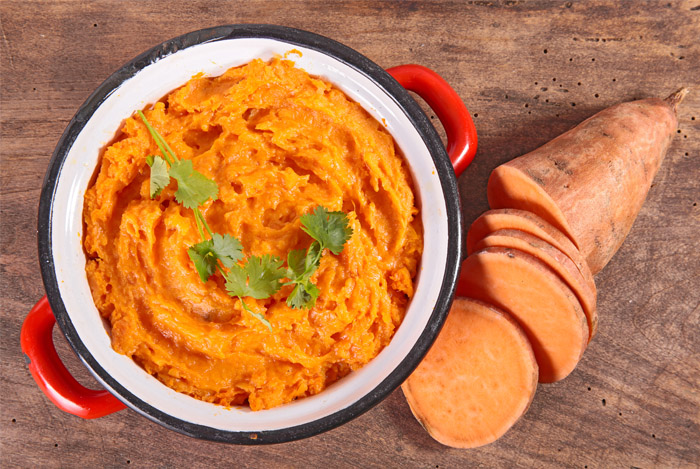
Strengthen Our Bones
Many studies have found that vitamin D deficiency contributes to the onset of at least two bone disorders—osteomalacia and osteoporosis (20).
This is because the endocrine pathway of vitamin D metabolism and its activities is solely responsible for monitoring calcium and phosphate concentration homeostasis in our plasma.
By doing so, the vitamin D is thereby protecting our bones from osteomalacia.
On the other hand, vitamin D also helps prevent osteoporosis due to its ability to improve bone marrow density and therefore prevent harmful fractures and breaks (20).
So, instead of just drinking a glass of milk all the time, try to include more vitamin D in your diet with such vegetables as sweet potatoes to reap the same benefits that milk provides.
Help Our Muscles
The amount of potassium in one cup of sweet potatoes accounts for nearly 30% of your daily potassium recommended intake.
Depending on whether the sweet potato is eaten raw, cooked, or roasted, it can provide a maximum of almost 950 mg of potassium (6).
Our body constantly needs a specific concentration of sodium and potassium because they move in and out of our cellular membranes, causing our muscles to contract or relax.
Studies have investigated exercise physiology for decades, and we now know that when we work out potassium ions are released from contracting muscles, while following exercise, some of the potassium concentration is restored.
Therefore, the net loss and associated net gain of potassium ions during workout likely contributes to the pain felt during prolonged exercise (21).

May Help Treat Alzheimer’s Disease
We have all either heard of or been affected by neurodegenerative disorders, whether directly or indirectly.
Such diseases take a toll not only on the patient but also on his or her caregivers and close peers as well since the mind shrinks slowly and slowly until even family may be unrecognizable.
It’s understandable why these are some of the most dreaded diseases possible.
Research for therapies, treatment, and preventative measures has been underway for many years, and while progress has been made, no definitive answers have yet been uncovered.
Recent studies concerning the role of vitamin D in these neurodegenerative disorders are beginning to blossom (22).
Epidemiological and experimental evidence points to the possibility that vitamin D is important in Alzheimer’s.
Tests have suggested that human brain cells in culture respond to vitamin D treatments by regulating genes involved in the control of neuroinflammation (22).
Since the inflammatory component of Alzheimer’s is a hallmark of the disease, preventing or at least attempting to treat such inflammation is a major step for neurodegenerative therapy.
Eating sweet potatoes (and their vitamin D) every day does not prevent Alzheimer’s, but it is a protective measure that could only help you in the future.
Help Us Relax
You may be surprised to know that anxiety disorders are the most common mental illness in the United States, affecting forty million adults eighteen years or older.
Depression is also one of the most common mental illnesses in the U.S. (23).
Recent studies have been discovering the relaxing effects of magnesium, thereby naming it the original “chill pill.”
Findings have shown magnesium ions to have therapeutic potential in helping to treat disorders (24).
Examination of EEGs and endocrine systems suggests that magnesium acts upon the limbic, hypothalamus, pituitary, and adrenocortical axes, which all act in ways to support our homeostatic functions and hormonal release.
What is even more interesting is that all these systems affect depression.
Magnesium seems to repress parts of the hippocampus and also represses the release of certain hormones, making it promising for depression treatment (24).
Additionally, several studies have found that magnesium supplements successfully relieve premenstrual mood changes in women.
For patients in the study, those treated with magnesium supplements reported their “negative effect” to be significantly reduced, whereas the control groups did not see such a dramatic change in their mood (25).
Luckily, sweet potatoes provide lots of magnesium for mood-boosting potential while also satisfying cravings as well!

Prevent Oxidative Damage
Fruits are well-known for being able to stop free radicals and oxidative damage.
Anthocyanins are pigments in a variety of colored plants that have recently been shown to possess antioxidants capabilities.
Dark fruits usually have the most antioxidant potential because they are more pigmented and have a greater concentration of anthocyanins.
Purple-fleshed sweet potatoes contain the highest amount of antioxidants compared with their orange and white-fleshed counterparts (26).
Interestingly enough, the anthocyanins in purple-fleshed sweet potatoes act as antioxidants in the sweet potato storage roots, and that antioxidative activity can actually be increased when paired with certain acids.
Antioxidants are so important because free radicals are being formed in your body all the time, but our body uses the antioxidants that we get from food to donate an extra electron and thereby destroy the free radicals of their harmful potential (26).
As we age, we naturally accumulate more and more free radicals, which, in turn, cause many diseases that also come with age.
Anti-Inflammatory Benefits
Several studies have been conducted specifically to investigate the anti-inflammatory effects that sweet potatoes can provide.
Most of these have focused on purple-fleshed sweet potatoes because these contain the most anthocyanins and the most antioxidants because of their deeper color (26).
In one particular study, adipocytes were treated with an extract from purple sweet potatoes in varying concentrations, and researchers measured certain changes in the adipocytes to investigate the factors after the potato treatment.
Scientists found that the purple sweet potato treatment suppressed the expression of mRNAs of inflammatory factors, meaning that these inflammatory markers were not created, and no inflammatory response could be produced (27).
Similar studies have found that this purple sweet potato extract suppresses the production of nitric oxide and proinflammatory cytokines, which also contribute to a lack of inflammation in the body (28).
Because inflammation is so important in many diseases and illnesses, keeping it in check is essential to our well-being.

Reduce Risk of Stroke
Many studies have focused on the role of potassium, magnesium, and calcium and their ability to reduce the risk of cardiovascular disease, but only several recent studies have started to look at potassium’s role in reducing the risk of strokes.
Since we have already examined how potassium can also help to reduce high blood pressure or hypertension, it would rightly be assumed that this same nutrient could also help prevent someone from having a stroke.
The most common type of stroke is called an “ischemic stroke,” which is the result of an obstruction in your blood vessels that carry blood to your brain (29).
The longer your brain goes without blood and therefore oxygen, the more damage can occur.
Potassium helps regulate your blood pressure, which is one of the major risk factors for strokes.
This is why controlling your hypertension or high blood pressure is so important.
Potassium helps prevent clots and obstructions from forming in your arteries and thereby can help decrease your stroke risk (29).
Although there is no direct cause-and-effect relationship regarding potassium and strokes, many studies have focused on both middle-aged men and women and their risks of stroke.
There seems to be a clear, inverse relationship between the amount of potassium you consume and your risk of a stroke (30).
Because the sweet potato is packed with potassium, it is a great way to quench your hunger and keep your arteries clear!
Help Create New Red Blood Cells
Our blood is composed of about 55% blood plasma and close to 45% of other types of blood cells (31).
Of the solid particles that make up blood, 99% of them are erythrocytes, or what we call red blood cells.
Each of these red blood cells contains an important component called hemoglobin, which has the main job of carrying oxygen throughout the body.
In the blood vessels in the lungs, the red blood cells pick up oxygen from the air we inhale, carry it throughout the bloodstream, and transport it to the parts of our body that need it most (31).
When cells in our body use this oxygen, they release carbon dioxide as a waste product, which the red blood cells then also pick up and carry back to the lungs where we exhale it.
Vitamin B12 is a nutrient in the vitamin B complex that cannot be synthesized by the body and therefore needs to be retrieved by other means.
This specific form of the vitamin helps create new red blood cells for the body to use as well as other vital components, such as DNA and RNA (32).

Control Our Metabolism
Enzymes are the hallmarks of our bodies because they help speed up our metabolic and biological processes (33).
Without enzymes, our bodies could not function properly because all the processes would be taking place too slowly, and nothing would ever get done.
Because we have enzymes that speed up things in an efficient manner, we can live and breathe and experience life the way that we do.
Many of these enzymes are activated by certain compounds and nutrients, one such being manganese, and these enzymes are essential in the metabolism of carbohydrates, amino acids, and cholesterol.
Both pyruvate carboxylase and phosphoenolpyruvate carboxykinases are manganese-containing or manganese-activated enzymes that are critical to the production of glucose in our bodies by noncarbohydrate precursors.
Since many processes in our body use glucose as their energy source, it is clear why producing glucose has such vital importance.
It should also be clear why manganese is just as important since it sets the foundation for these enzymatic workings to take place.
Sweet potatoes are one of several foods that have a hearty portion of manganese packed inside them, making them extremely beneficial for controlling our metabolism and metabolic functions (33).
May Help Huntington’s and Parkinson’s Diseases
Along with Alzheimer’s, Parkinson’s, and Huntington’s diseases are other devastating neurodegenerative diseases.
Huntington’s disease involves the loss of neurons in the striatum, which causes severe cognitive and physical deficits, all due to one gene abnormality (34).
Huntington’s is notorious for causing involuntary jerking and writhing movements.
Parkinson’s, although similar, is caused by enormous decreases in dopaminergic signaling in the motor cortex of the brain, leading to tremors usually in the limbs, as well as slowed movements called bradykinesia.
Recently, studies have found that ascorbate (vitamin C) as a pharmacological agent may be helpful in therapy for Parkinson’s disease patients since there is evidence that this vitamin increases the availability of levodopa, or L-dopa, in the brain, which is a compound then converted into dopamine (34).
Because the foundation of Parkinson’s lies in low dopamine levels, L-dopa supplementation is used to treat this disease.
However, if a beneficial nutrient can be used to increase internal levels of this compound without taking another drug, therapy and even a cure may be possible.
Additionally, several studies have found that mice expressing the Huntington’s gene have a deficit in their striatal ascorbate release.
Injecting the mice with ascorbate was found to reverse the deficit and improve the disease’s notorious behaviors, such as repetitive motions (34).
Because sweet potatoes are extremely rich with vitamin C, you should include more of it in your diet.

Help Treat Herpes
The Epstein-Barr virus is a member of the herpes family that mainly targets lymphocytes and epithelial cells and establishes a lifelong persistence in memory B cells (35).
The key to treating the Epstein Barr virus is suppressing viral replication so that the virus cannot spread. Fortunately, research has seemingly found a treatment that is as simple as it gets—vitamin C.
One particular study was conducted between 1997 and 2006, where patients diagnosed with this virus were treated with high doses of intravenous vitamin C.
Researchers found that the large doses of ascorbic acid had a greatly positive effect on the duration of the disease as well as on the number of viral antibodies (35).
Because there is currently no treatment for completely removing the Epstein-Barr virus from a patient’s body, the next best thing seems to be utilizing vitamin C to combat the viral infection.
Because sweet potatoes contain more than 50% of your daily vitamin C needs, it is an obvious choice for making sure you have enough vitamin C in your diet and warding off such things as the herpes virus.
Can Help Control Epilepsy
Sweet potatoes are high in the nutrient manganese, and blood concentration of manganese in epileptic patients has been a topic of discussion recently.
In rats, manganese deficiency was found to increase the animal’s susceptibility to electroshock-induced convulsions (36).
In humans who have epilepsy, researchers found that their whole blood manganese levels were significantly lower than the control groups that did not have epilepsy—nearly 20%–40% percent lower to be exact.
These same patients had normal or close to normal levels of copper and zinc, suggesting that the correlation between manganese deficiency and epilepsy is not simply a result of malnutrition.
On the other hand, patients who had epilepsy due to trauma had higher blood manganese concentrations than those without trauma epilepsy, which suggests that manganese deficiency is a factor for epilepsy and not a result of it (36).
Several studies have found that varying doses of manganese can be helpful in controlling epilepsy, especially in those patients with low blood levels of manganese in their system.
The doses must be above a certain level; otherwise, the element has been found to be ineffective (36).
Because of the high levels of vitamin C in sweet potatoes, it can only be inferred that consuming sweet potatoes and their vitamins could help people suffering from epilepsy to control their disorder and maintain a life that they are more in control of.

How to Buy and Store
Just as with buying many other types of products, when choosing sweet potatoes you want to make sure they are firm and do not have any cracks, soft spots, or bruises.
Because cold temperatures are detrimental to sweet potatoes and their delicious taste, try to avoid buying those that are kept in a refrigerated section in the grocery store.
If all of a store’s supply of sweet potatoes is refrigerated, you may want to try buying produce from another store, or, if that is not possible, you can still purchase cold potatoes; however, they will probably just not have their usual taste anymore.
While on the subject, sweet potatoes should not be stored in cold or refrigerated areas.
They should, however, be kept somewhat cool and stored in dark, dry, and well-ventilated areas.
Likewise, you want to be careful not to store these potatoes where there may be excess heat, such as in a cupboard above the stove top.
If you follow such guidelines, your sweet potatoes should stay fresh for about ten days (6).

How to Include More Sweet Potatoes in Your Diet
Most people break out sweet potatoes for Thanksgiving every year or maybe even for Christmas as well!
With so many health benefits and nutrients that this root vegetable offers, you should also consider adding sweet potatoes to your everyday diet instead of only twice a year.
Sweet potatoes can be easily added to your lunch, snacks, dinner, and even dessert!
Although having sweet potatoes for breakfast sounds a bit unconventional, you surely won’t be questioning it after you taste these fluffy sweet potato waffles!
The first thing you have to do is simply mix together flour, sugar, baking powder, baking soda, salt, allspice, and ginger.
Then combine the dry ingredients with a mixture of milk, sweet potatoes, eggs, and vanilla.
By ladling about a ½ cup of the slightly lumpy mixture onto your heated waffle iron, you will produce fluffy, melt-in-your-mouth waffles that can be served with a scoop of butter and drizzled with gooey maple syrup.
How does that sound for a healthy, yet delicious way to start your day?
Most people reach for the chips and dip, a granola bar, or maybe an apple when you’re halfway through the day and need a quick snack to help you carry out the rest of your activities.
Sweet potatoes probably don’t come to mind at such a time, but they should!
We all know and love the classic sweet potatoes or sweet potato French fries, but one way to have sweet potatoes as a midday snack is by making them just a bit more exciting.
You can make these honey-roasted sweet potatoes with honey cinnamon dip.
By cutting up two to three large sweet potatoes and dicing them, you will have delightful bite-sized pieces to snack on.
Dump the cubes into a bag and add honey, oil, cinnamon, and pumpkin pie spice, and mix carefully.
Then transfer the seasoned potato cubes onto a baking tray, where you will bake for about twenty to twenty-five minutes.
Flip the potatoes over, and then bake for another fifteen to twenty minutes.
While they are baking, make sure to whip together the creamy honey cinnamon dip, as these sweet potatoes are definitely not complete without it.
All the dip requires is some vanilla Greek yogurt or sour cream, two to three tablespoons of honey, and one teaspoon of cinnamon.
Whisking these ingredients together will create a perfect blend of sweetness to complement your mouthwatering sweet potatoes!
If you want to take the quicker route for a snack, then simply whip together an easy sweet potato salad!
Once again, cut up one or two sweet potatoes into bite-sized cubes, where they will then be steamed alongside some tofu and broccoli.
Once they are done steaming, pour the ingredients into a large bowl and toss in some raisins and drizzle with a curried vinaigrette dressing.
What’s even better is that the oil in the vinaigrette helps to improve the availability to beta-carotene in the sweet potatoes, enhancing both the flavor and the nutrition packed inside this root vegetable.
Finally, everyone knows that meals just aren’t complete without dessert at the end, and there’s no excuse why you can’t also include some sweet potatoes in this part of the meal!
For all, you pumpkin pie lovers out there, prepare to go crazy over this twist on a holiday classic—sour cream sweet potato pie!
All your usual ingredients are in this pie—flour, sugar, salt, butter, cinnamon, and nutmeg, but we now add some sour cream and pureed sweet potatoes.
Mixing all those ingredients together and spreading them smoothly over a buttery, flaky crust will have everyone drooling.
Fifty to sixty minutes in the oven will allow all the flavors to marinate, which makes for a delicious after-dinner treat that you don’t have to feel so guilty about!
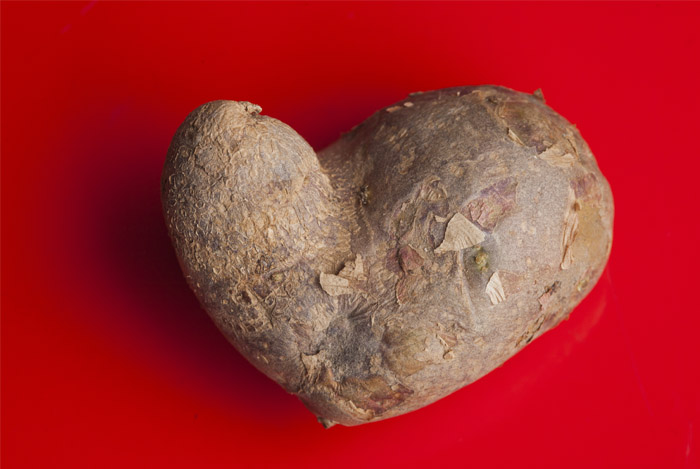
Precautions
As with everything else, sweet potatoes should be eaten in moderation.
Specifically, sweet potatoes can be slightly dangerous for people with past or current kidney stone problems.
Sweet potatoes contain a very high content of oxalates, which is a substance found in many plants that may combine with calcium to form crystal-like masses, leading to kidney stones.
Additionally, eating too many sweet potatoes and the oxalate they contain may contribute to inflammation, which may then trigger inflammatory conditions, such as rheumatoid arthritis.
To get a sense of the amount of oxalate in sweet potatoes, most high-content foods are said to contain about one to fifty milligrams of oxalate per serving.
Meal plans with a low number of oxalates limit oxalate intake to about fifty milligrams per day.
So, if you are a former or current kidney stone patient, or even if you are just being conscious of your eating habits and are trying to limit your oxalate intake, this would limit you to a little less than one sweet potato a day.

Conclusion
Overall, it is clear that sweet potatoes are more than just a simple side-dish that no one wants at Thanksgiving dinner.
Contributing almost 200% of your daily recommended intake of vitamin A, this orange vegetable may have the power to help millions of citizens in underdeveloped countries fight against eye diseases and general macular degeneration.
What’s more is that sweet potatoes also contain 50% of your daily intake of vitamin C, which can benefit you in so many ways due to this vitamin’s anti-inflammatory properties and wonderful immune assistance.
If all these benefits haven’t excited you yet, you should also be happy to realize just how versatile and easy sweet potatoes are, as they can be included with breakfast, lunch, dinner, and even dessert.
FDA Compliance
The information on this website has not been evaluated by the Food & Drug Administration or any other medical body. We do not aim to diagnose, treat, cure or prevent any illness or disease. Information is shared for educational purposes only. You must consult your doctor before acting on any content on this website, especially if you are pregnant, nursing, taking medication, or have a medical condition.
HOW WOULD YOU RATE THIS ARTICLE?



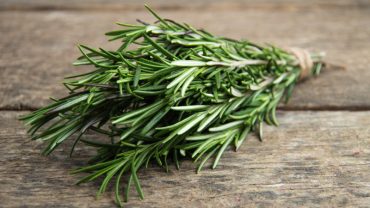



Are sweet potatoes a high-calorie type of food?
Do sweet potatoes help prevent Alzheimer’s disease or just help in curing?
What portion of sweet potatoes should I eat to receive my daily vitamin C dose?